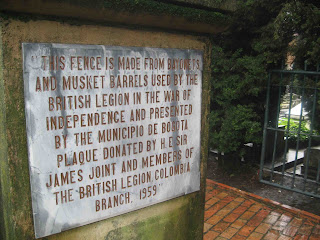Whenever I read these rankings, I'm struck not by how 'good' Bogotá is, but by how lousy other cities must be doing for Bogotá to rank relatively high.
 |
| Curitiba, Brazil: Efficient transit, green spaces and clean air. |
Bogotá did pretty well in areas such as energy use, green space, land use and transport - but to a great extent because of its relative poverty and lack of development. With the country's armed conflict having been pushed back, the economy growing, car ownership increasing and planned freeways and land use policies likely to feed sprawl, I expect Bogotá's environmental performance to decline in the coming years.
 |
| A view from the hills overlooking Bogotá |
Bogotá officials could accomplish a lot by reading this report and adopting the good ideas from other cities. Some are no-brainers, such as instituting random pollution checks (with recorded, automated devices to minimize corruption) on vehicles. (The report erroneously compliments Bogotá for equipping its Transmilenio buses to operate on natural gas. Unfortunately - and incomprehensibly - the city has not done this, although many taxis have been converted to natural gas.)
 |
| Belching Bogotá bus - isn't anybody watching? |
Bogotá might also restart its bicycling-promotion policies, forgotten by recent mayoral administrations.
Another good move would be creating a strict land-use plan and sticking with it through mayoral administrations. Curitiba, Brazil has moved poor residents from informal housing into new, better-built housing with access to transit and city services. Bogotá could do the same with some of the neighborhoods covering its Eastern Hills. Many of these neighborhoods are located on steep, unstable land and suffer high crime rates and other problems. By offering residents incentives to move into solider, more compact housing, the city could improve its waste-water treatment rates and recover land for green spaces and forest.
"Urban sprawl has also put limits on policy options. As detailed below and in the city profiles, vehicle numbers are having negative effects not just on transportation but on air quality and greenhouse gas emissions.
"Add in everything: More cars means more traffic jams, less time with family; more and wider roads means less green space.
"Many Latin American cities have successfully set up extensive public transport systems. However, they have not performed as well on the more sensitive challenge of getting people out of their cars. But those efforts are necessary to address the region’s deeply entrenched culture of individual transportation.
"Policies to reduce the number of cars on the road are rare. Just two cities have park and ride schemes. None currently has carpooling lanes. Only Santiago, rated well above average in this category, has a congestion charge. ‘Comprehensive public transport networks are only part of the solution to reducing reliance on cars. Index figures indicate that the number of vehicles per person in a city goes up with income per capita, independent of the quality or size of the public transport system."
And later:
"As the city profiles show, however, the big problem for many cities is vehicle traffic. Those with strong policies on car and truck emissions testing or the promotion of public transport tend to do better. Curitiba is ranked well above average, and its BRT system is often cited as a reason for its better air quality."
All of which makes me ask: Why hasn't Bogotá implemented basic, proven, no-brainer anti-congestion measures like car-pool lanes, ride-sharing programs, park-and-ride lots and, best of all, a congestion charge?
By Mike Ceaser of Bogotá Bike Tours




















































